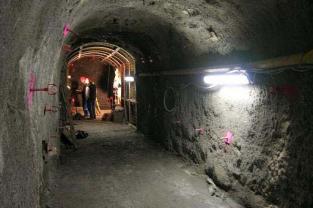The Rhin-Rhône High Speed Railway Line project crosses a steep relief in Section “C” by the Chavanne tunnel, about 1970 m long (Doubs and Haute- Saône departments).
After the first soil-testing campaigns including classical investigation means (boreholes, laboratory tests), some information was still missing to describe the geotechnical behaviour of the Toarcian marl. It was decided to further investigate this layer by excavating a shaft providing access to an exploratory gallery, that would be
parallel to the tunnel and at a short distance.
The following operations were performed within the structure, in order to characterise the in-situ behaviour of the Toarcian marl:
- In-situ observation of materials and of their behaviour with time after excavation.
- Monitoring of the gallery lateral convergences and of the tunnel face extrusion using INVAR or optical wire.
- Laboratory tests (identification, triaxial, creep and swelling).
- Plate loading test profiles along the horizontal and vertical directions.
- Flat jack test profiles in order to characterise the stress field.
Different types of support structures were implemented and monitored in the gallery in order to collect information about the behaviour of temporary/permanent supports: welded mesh shotcrete, nailed shotcrete, and light arches with shotcrete.
In addition, pull-out tests were performed on two types of nails: HA25 and
Swellex bars.
The collected information were then used in back-analysis calculations to define the input data for the design of the Chavanne tunnel.
Terrasol’s achievements:
Within the Rhin-Rhône High Speed Railway Line project, TERRASOL acted as a geotechnical consultant for the Project Manager (Setec).
TERRASOL was entrusted with: definition of the soil-testing campaigns for the A and C sections, design of the structures for A and C sections, and checks of detailed design and works of the project.
 Agent Access
Agent Access 




